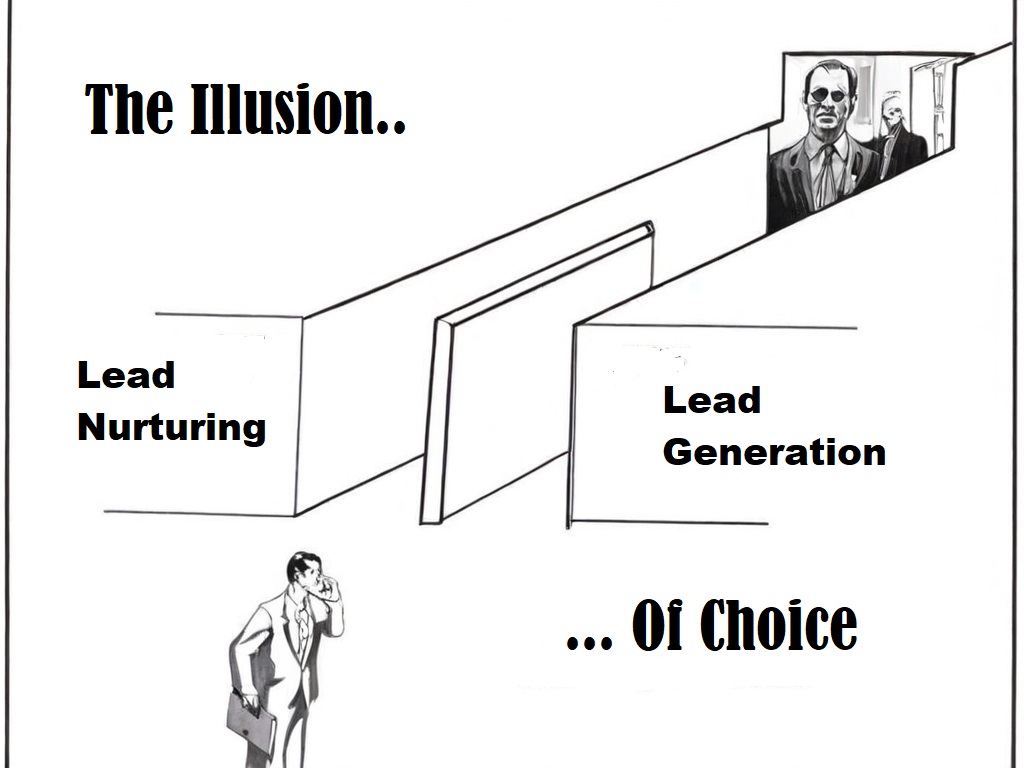Did you know that nurturing leads can make them 50% more sales-ready, according to research? Yet, many businesses struggle to differentiate between nurturing these potential customers and merely generating more leads. But what if you could not only capture leads but also guide them towards a sale through effective nurturing? That’s precisely the art of lead nurture in the B2B sales arena.
Understanding the nuanced dance between drawing in new leads and carefully cultivating them to fruition is pivotal. This guide aims to shine a light on the importance to lead nurture—a crucial, if sometimes misunderstood, aspect of the sales process—and provide actionable strategies to leverage both lead generation and nurture in your business.
Why Lead Nurture?
Lead nurturing is the process of developing and reinforcing relationships with buyers at every stage of the sales funnel. It focuses on listening to the needs of prospects, and providing the information and answers they need. Lead nurture is all about keeping your brand at the forefront of your potential customers’ minds, establishing a connection until they’re ready to make a purchase.
Lead Nurturing vs. Lead Generation: Clearing the Confusion
When we talk about bridging the chasm between attracting potential buyers and actually converting them into loyal customers, two critical concepts emerge: lead generation and lead nurturing. While both are integral to a successful sales strategy, they play fundamentally different roles. Lead generation kicks off the journey by drawing prospects into the sales funnel, but it is lead nurturing that carries them through to the decision-making phase. To put it simply, while lead generation is the act of capturing interest and creating a pipeline of potential customers, lead nurturing is the strategic follow-up that moves these leads through the sales funnel.
Here, we are going to cover a more detailed exploration of their differences and why mastering both is crucial for your business.
Building Connections vs Making Connections Last
- Lead Generation: This first step is akin to making introductions at a large networking event. The communication is relatively broad and generic, aiming to cast the net as wide as possible. In many cases, this involves one-time communications like social media blasts, cold emailing, or PPC (pay-per-click) advertising campaigns. The goal here is to spark initial interest and gather a wide array of leads.
- Lead Nurturing: In contrast, lead nurturing resembles the one-on-one conversations that follow initial introductions. After identifying potential customers, nurturing requires a series of targeted, consistent interactions. These are not random or generic blasts but carefully crafted messages meant to guide the prospects through the sales funnel. Effective nurturing communication is frequent enough to keep your brand top of mind but spaced appropriately to not overwhelm the lead. It’s a delicate balance that requires insight into customer behavior and preferences.
General Content vs Specific Content
- Lead Generation: At the outset, the content needs to appeal to a broad audience. The messaging is designed to resonate with a general audience, broadly outlining the problems your product or service solves. It’s about creating awareness and interest, often leveraging emotional or attention-grabbing hooks.
- Lead Nurturing: As the relationship progresses, the importance of personalized content cannot be overstated. This stage revolves around understanding and addressing the specific needs, challenges, and interests of each lead. It might involve segmenting your audience based on their behaviors, interests, or how they’ve interacted with your content previously. The content becomes more detailed and nuanced, providing solutions to precise problems the prospect has expressed or demonstrated through their interactions with your brand.
Filling Sales Funnel vs Sustaining Relationships
- Lead Generation: The primary aim here is to fill the top of the sales funnel as efficiently as possible. It’s a numbers game, focusing more on quantity with an eye toward immediate ROI. Fast conversions are celebrated, but the approach doesn’t necessarily build lasting relationships with each lead.
- Lead Nurturing: On the flip side, nurturing is the long game. It’s about building a relationship with each potential customer, providing value, and establishing trust over time. This phase can significantly impact customer lifetime value, as the focus shifts from making a quick sale to fostering a long-term partnership. The ROI may not be immediate, but the cumulative effect of nurturing leads to more significant and sustained growth for the business.
Lead Generation with Lead Nurture
Understanding the distinct roles of lead generation and lead nurturing within the sales funnel is crucial, but the real magic happens when businesses learn to leverage both effectively. Seamlessly integrating these processes can transform your sales strategy, turning cold leads into loyal customers. Let’s now go into how to we can use both for maximum impact.
From Generation to Nurturing
The handoff from lead generation to nurturing should be seamless. You don’t want warm leads from your lead generations efforts to slip through the cracks nor do you want the way your converse to be different between your lead generation and nurturing process. Here’s some aspects that affect a smooth transition:
- Automation: Leverage CRM (Customer Relationship Management) systems and marketing automation tools to ensure that once a lead is captured via your lead generation channels, they are automatically enrolled into your lead nurturing sequences. This involves setting up workflows that trigger based on specific actions a lead takes, such as filling out a form or downloading a resource.
- Consistent Messaging: Make sure the communication tone, style, and brand messaging are consistent from your initial interaction. If a lead encounters a disconnect between what attracted them to your brand and what they experience in the nurturing phase, it could lead to disengagement.
- Immediate Engagement: The interest of a lead is highest when they first engage. Ensure that your nurturing starts with a strong, engaging message that acknowledges their interaction or interest shown during the lead generation phase. Welcome emails or messages that provide immediate value or further insight into their initial interest can be particularly effective.
Make use of Data and Feedback
The process itself isn’t a one time thing per lead. You would need to continuously analyze the data from your interactions with leads. Which content topics drive the most engagement? How quickly do leads progress through the sales funnel? These kind of questions will naturally pop up as you leverage both lead generation and nurturing. Here’s how it looks like in points:
- Analytics: Utilize tools to gather detailed analytics on how leads interact with your content. Look for patterns like click-through rates, most-viewed pages, and download rates. Tools like Google Analytics, coupled with your CRM’s analytics, can offer deep insights into lead behavior.
- Feedback Loops: Implement mechanisms to collect feedback directly from your leads and customers. Surveys, feedback forms, and direct outreach can provide qualitative data that analytics might not capture, offering insights into your audience’s preferences and pain points.
- Adaptation: Use the collected data and feedback to refine your lead generation and nurturing strategies continually. If certain content types are consistently engaging, produce more in that vein. If certain email subject lines or calls-to-action (CTAs) result in higher open or click rates, incorporate these elements into your broader strategy.
Implement Two-Way Communication
A lead who is heard is more likely to convert! Encourage feedback and questions from your leads. Provide venues for them to do so as well. This not only provides valuable data but also reinforces the relationship.
- Channels for Interaction: Provide multiple avenues for leads to reach out to you. This can include email, social media channels, chat services on your website, and even traditional forms like phone calls. Each lead has a preferred communication channel, and offering choices increases the likelihood of them reaching out.
- Responsiveness: Ensure your team is equipped to respond promptly to inquiries and feedback. Quick, thoughtful responses can significantly enhance lead trust and loyalty, pushing them further along in the nurturing process.
- Engagement Strategies: Periodically check in with leads with personalized messages that encourage dialogue. Questions, surveys, interactive content, and forums can be effective methods to invite communication.
Evaluate and Adjust
Lastly, there will always be a need to regularly review the effectiveness of your strategies. Your strategies might be effective when you’re using it, but the market climate is ever changing. Don’t get swayed by the waves the wrong way! Here’s how you can evaluate and adjust effectively:
- A/B Testing: Constantly test elements of your lead generation and nurturing campaigns. This could include experimenting with different email subject lines, landing page designs, content formats, or communication frequencies. Measure performance against defined metrics such as engagement rates, conversion rates, and ultimately sales.
- Iterative Improvements: Use the insights gained from A/B testing and analytics to make iterative improvements to your campaigns. It’s crucial to understand that optimization is an ongoing process, not a one-time setup.
- Flexible Strategies: Be prepared to pivot your strategies based on performance data and changing market conditions or customer behaviors. The digital marketing landscape and consumer preferences evolve rapidly; your lead management strategies should be dynamic enough to adapt.
To end it off, only lead nurturing or lead generation will not cut it: both are necessary to be effective. By understanding the differences between lead generation and nurturing, and implementing a robust strategy that caters to the specific needs of your leads, you not only improve your conversion rates but also build a foundation of trust with your potential customers.
Interested in reading more posts like this? We cover the topics of B2B Digital Marketing, Lead Generation and Nurturing every week! Get started by clicking on this link here!















Leave a Reply